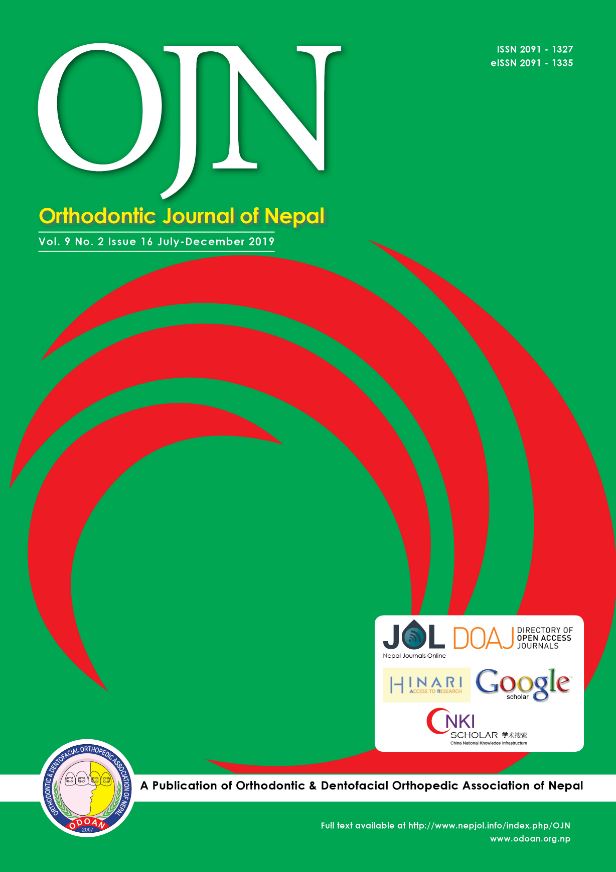Periodontal Parameters Alterations with Use of Conventional Bracket and Self-ligating Brackets
DOI:
https://doi.org/10.3126/ojn.v9i2.28403Keywords:
Conventional brackets, Periodontal status, Self-ligating bracketsAbstract
Introduction: Different bracket systems are available in the market claiming to have some advantage over the other. Conventional brackets and the self-ligating brackets are the most common. Though both the systems work basically similarly, the difference between the two system is principally in the ligating technique. The advantage of conventional brackets claimed are faster tooth movements and improved oral health of the patient.
Materials & Method: A total number of 20 patients were shorted from the waiting list meeting the selection criteria. With the help of random number generator, two groups with 10 subjects each were created for conventional brackets (0.022 Slot MBT brackets) and self-ligating brackets (0.022 Slot DAMON prescription) respectively. The patients were blinded regarding the selection of the brackets. The brackets were bonded according to the random number allocation. After the bonding, the periodontal parameters i.e. gingival index (GI), plaque Index (PI) were measured again at an interval of 60 (T1) and 120 days (T2). Periodontal indices were calculated by summing the mean score of each examined tooth and dividing by the number of the evaluated teeth. Data collection was done with the help of a periodontal probe. All the records were taken by the same periodontist to avoid inter-examiner variability. To reassure that there is no any intra-examiner variation for periodontal status, the same periodontist re-measured the periodontal parameters again of 10 individuals selected randomly after 7 days from the initial measurements. To examine the intra-examination variability, Dahlberg’s formula was used between the two readings taken at a span of 7 days of the same subjects. The mean value of Plaque index and Gingival index was checked for normal distribution applying Kolmogorov- Smirnov test. One-way ANOVA test was applied for comparison between and within groups for plaque index and Gingival index during three different period in Conventional brackets and Self-ligating brackets. Post hoc Bonferroni test was applied for multiple comparison. Independent t-test was applied for comparison between conventional brackets and self-ligating brackets to compare the plaque index and gingival index. All data were test were analyzed at P<0.05.
Result: There was no any significant difference between T0 and T1 and between T1 and T2 in both the conventional brackets and self-ligating brackets. However, there was statistical difference between the time period from T0 to T2. There was also no any significant difference between conventional bracket and self-ligating brackets in terms of plaque index and gingival index.
Conclusion: There are no advantages of self-ligating brackets over conventional brackets in terms of periodontal status.
Downloads
Downloads
Published
How to Cite
Issue
Section
License
Copyright © held by Orthodontic & Dentofacial Orthopedic Association of Nepal
- Copyright on any research article is transferred in full to the Orthodontic & Dentofacial Orthopedic Association of Nepal upon publication in the journal. The copyright transfer includes the right to reproduce and distribute the article in any form of reproduction (printing, electronic media or any other form).
- Articles in the Orthodontic Journal of Nepal are Open Access articles published under the Creative Commons CC BY License (https://creativecommons.org/licenses/by/4.0/)
- This license permits use, distribution and reproduction in any medium, provided the original work is properly cited.




